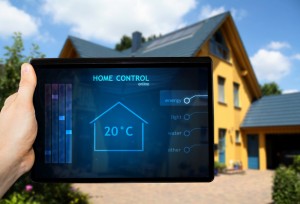Share This
Related Posts
Tags
Wired Home
By Geneva Ives on May 7, 2013 in Technology | 1 Comment
 Imagine driving up to your house after a long day of work. The garage door opens without touching a button. The front door unlocks – no need to fumble around for your keys – and the lights flip on. Your TV tunes to your favorite channel before you even take off your coat.
Imagine driving up to your house after a long day of work. The garage door opens without touching a button. The front door unlocks – no need to fumble around for your keys – and the lights flip on. Your TV tunes to your favorite channel before you even take off your coat.
Is this a dream? No. Welcome to your automated home.
Home Automation Past & Present
Home automation became accessible in the late 1970’s when X10 technology was made available to the American public. X10 modules allow compatible electronics to communicate via existing power lines in a house. Although X10 is relatively affordable, it is also somewhat complicated and time consuming to install. Home automation in the early days largely remained the pursuit of techy hobbyists and wealthy homeowners.
Today’s widespread smartphone and tablet technology has now opened up home automation to a broader audience. Some companies are offering devices that allow users to control a single function wirelessly or automate it all together. The Nest Learning Thermostat is a smart thermostat that connects to Wi-Fi, allowing it to be controlled remotely using a mobile app. You can adjust the temperature of your home from anywhere. Additionally, Nest learns your climate preferences and creates a schedule that optimizes your energy use. Nest even knows when you’re out of the house and self-adjusts to save power.
Other forward-thinking businesses are offering more comprehensive home automation services. Comcast, a national media and technology company, touts their XFINITY® Home package as “the total home security and home control solution that keeps you connected to what matters most.” For less than $50 a month, XFINITY® Home allows you to control your security system, adjust your lighting and access your thermostat from your smartphone, tablet or computer.
Better still, you can program integrated automated systems to work together. For example you can tell your home to turn down the heat when you arm the alarm, giving you one less thing to worry about when you walk out the door in the morning.
Automation Benefits for Tenants & Landlords
Home automation isn’t just a good idea, it’s also a green idea. Automation yields multiple benefits, chief among them being the energy efficiency that comes with having a well-regulated HVAC system. Studies show that building automation can result in consistent energy savings between 5% and 15%. Boost savings by adding automated occupancy sensors to switch off appliances that have accidentally been left on to reduce unintentional energy usage.
Additional benefits of home automation include convenience, peace of mind and ease. You can manage your home from anywhere, check your security feed at any time and turn on the lights from your iPad without having to bump around in the dark. There is even home automation technology that will help you take care of your pet.
Home automation is more than just a passing trend. It’s the future of real estate. A recent Better Homes and Gardens Real Estate survey revealed that 41% of Millennials would be more likely to brag to a friend about a home automation system than a renovated kitchen.
Residential complexes can enjoy significant energy savings and other perks from automation. Automated units are in demand and can be marketed as “smart homes” that enjoy technologically advanced features and added security. In fact, the value of the smart home market is estimated to climb to $60 billion by the year 2017. Home automation “future proofs” your properties, ensuring a steadily increasing listing value for years to come.
Ready to try your hand at a little recreational home automation? Here are ten DIY projects to get you started.
Editors’ note: Geneva Ives is the marketing writer for Point2, a leading provider of online marketing solutions for real estate professionals, including custom websites, syndication tools and prospecting utilities. She will be contributing technology-oriented real estate interest posts to The Balance Sheet.

Look forward to when our homes do the talking for us when it comes to materials needed for improvements and how to spec a job for Contractor interviewing. Maybe allow me to be in an appliance or furniture store, scan the QR code and then see how it looks and fits in my place right from my smart phone.